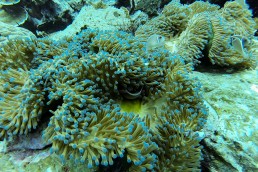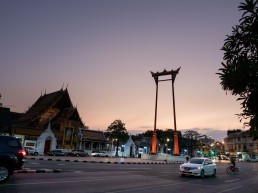If you’re reading this then you’re either already excited about learning to dive or you’re intrigued and curiosity is getting the best of you. Either way, I’m glad you’re here and I’m glad you’re considering to invest in learning a skill that will open your eyes to a new world, teach you about the ocean and give you a new way to enjoy travel. If you’ve watched our vlog then you’ll know that we cannot recommend doing a PADI open water diver certification enough and encourage you to take the plunge (both literally and figuratively)!
Check out the vlog below:
As for us, the decision to learn to dive almost came out of nowhere. After all, Tony had a fear of the open water and was not a particularly confident swimmer. Meanwhile, I feared what might be lurking down there in the dark blue and didn’t particularly feel the urge. However, the more time we spent in the ocean on our travels, the more intrigued we became and before long we found ourselves booked on to a PADI Open Water diver course on Koh Tao, Thailand.
The week we spent at Ban’s Diving resort learning to dive was one of the best weeks of our lives and led to some pretty incredible experiences around the world. As budget travellers, it was a big cost for us but it was absolutely worth it. The underwater experiences we had on the course and over the next few months were absolutely priceless.
First things first...
Once you’ve made that awesome decision to learn to dive the first thing to do is to decide what certification you need for what you want to be able to do. Then you need to decide where exactly to do it.
There are so many dive shops and dive locations out there it can be a little daunting to know where to start. For us, it was important that we picked somewhere with excellent reviews and ratings in terms of the quality of the course, safety and instructors. When you’re looking into locations, be sure to pick a PADI 5 Star Centre for peace of mind and a top notch experience.
We opted for Ban’s Diving resort in Koh Tao due to the excellent reviews and the fact that we couldn’t wait to spend another couple of weeks in one of our favourite countries in the world, Thailand.
It also happened to be very highly regarded whilst being on the cheaper end of the scale in terms of course and accommodation prices. For example, a course in the USA would cost significantly more and as we were already in Asia, it made sense for us to opt for a course in Thailand. There are dive resorts all over the world so no matter what your circumstances and budget there will be the perfect place for you.

In terms of pre-requisites all you need is to be aged 10 or over, be able to swim and are medically fit enough for diving. You don’t need any previous knowledge of diving as the PADI Open Water Diver course will take you through everything from learning about the equipment to your very first open water dive (and beyond).

About the course
Whilst PADI isn’t the only body offering scuba diving certifications, it is one of the most known and globally recognised, meaning that once you’re certified, you can rest assured that you will be able to enjoy scuba diving all over the world.
The PADI Open Water Diver course is the perfect course for those wanting to begin their underwater journey into scuba diving. It is a 3-4 day course introducing you to scuba diving techniques and theory in addition to 4 open water dives to learn, explore and gain confidence.
Once certified, you will be able to dive accompanied up to 18m (60ft), which actually means you’ll have access to up to 70% of our ocean planet – how cool is that? With your licence you’ll be able to rent scuba equipment, fill scuba cylinders and book diving excursions. Also bear in mind that you will be qualified to dive in conditions similar to which you were trained.


The schedule
The course is essentially made up of 3 main parts:
- Academic (online or classroom based learning with exam)
- Confined water diving (swimming pool)
- Open water diving (ocean / lake)
Those parts are structured as follows over the 3-4 days at Ban’s:
Day 1 (evening): Orientation to course
Day 2: Confined water & academics 1, 2 & 3
Day 3: Dives 1 & 2 (up to 12m) & academics 4, 5 & exam
Day 4: Dives 3 & 4 (up to 18m) & final paperwork
The academic portion and exam may sound intimidating but do not worry, it is an enjoyable and really interesting experience that will just get you more excited for what is to come. It focuses on diving principles, teaching you the whys and whats before you touch any actual equipment.
Outside of the classroom, the initial step is to learn about the equipment – how to use it, how to look after it and how to stay safe. This was done pool-side at Ban’s and involved plenty of practice before even entering the water.
Once in the swimming pool you’ll learn basic scuba skills before heading into open water. This may feel a little daunting as it does seem to all happen quite fast (the course is only 3.5 days after all) but rest assured that you are in very capable hands and are always supported if you are struggling with a certain aspect whether that’s the entrance, buoyancy or simply being able to stick with your buddy!


Costs & inclusions
Costs will vary depending on where you chose to do the course around the world. At Ban’s Diving resort in Koh Tao the PADI Open Water Diver course is 11,000 THB per person which is approximately £270 or $370 USD. That price includes all teaching, equipment, open water dives, examination and your PADI licence as well as snacks and drinks on the boat.
You can also opt to stay at Ban’s resort which we would recommend for ease and especially as most days you’ll begin pre-7am. Room rates are discounted for those doing the courses and there are a large range of rooms on offer from more basic, budget friendly options to deluxe suites and villas, it really just depends on how much you want to spend. Check out their website for current prices and room options.
If we can just advise one thing it’s that you don’t opt for the most basic, fan-only room. We made that mistake and were so hot that we didn’t sleep a wink the night before the course. We upgraded rooms the next day (from 400THB for a fan room to 800THB per night for an AC room) and it made for such a better overall experience.


Continued learning: Advanced Open Water
If, like us, you absolutely loved the experience and want to go further with your education then there are many options open to you. Some of the most popular options are: advanced open water diver, rescue diver and enriched air diver. And if you still can’t get enough then you could look into the professional courses which vary from divemaster all the way up to course director, the highest rating in recreational diving.
Before we’d even begun the PADI Open Water Diver course we booked onto the advanced open water to follow on straight after. We knew that we’d feel much more confident in the water with some additional learning and different types of dives. The course is over 2 days and involves another 5 dives including a deep dive (up to 30m), navigation dive and 3 elective dives chosen from a list of options such as night dive, wreck dive, underwater photography and nitrox.
Those additional 5 dives changed everything for us, gave us so much more confidence in the water and were some of the most incredible moments of the entire week. During the deep dive in Chumpon, Koh Tao, we had the absolute pleasure of diving with a large whale shark. Jumping into the sea to come face to face with such an incredible creature in its natural environment was an unforgettable moment that we are so grateful for. We also experienced a night dive, which despite my initial fears and reservations, was amazing. To find out more about the advance open water course and if it’s right for you, check out the official PADI site.



After a week spent at Ban’s immersing ourselves in the underwater world, we were in love. Truly, it had ignited a new passion as well as a new appreciation and love for the ocean and all of its inhabitants. What we once feared was now a skill that we would forever be glad we acquired. A skill that opens us up to all new kinds of adventures that not everyone is lucky enough to experience. If you’re debating whether or not to do it, then just go for it. It may set you back a little and won’t ever be your cheapest hobby, but it is an experience you will never forget.
Have you found a new love for scuba diving? Let us know in the comments!
Happy adventuring,
Lorna
Share

THAILAND VLOG SERIES
We have a whole vlog series on youtube from our travels in Thailand – check them out over on our channel by clicking below.
Related posts
A guide to Siargao, Philippines
Our first stop in the Philippines was the incredibly beautiful Siargao, also known as the surf…
10 things you must do in Bangkok, Thailand
Bangkok really does have a little bit of everything, from brilliant shopping to delicious food and…



